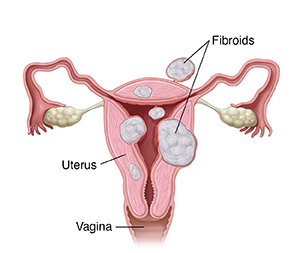Understanding Robotic-Assisted Myomectomy
Robotic-assisted myomectomy is a type of surgery. It’s done to remove growths in the uterus. They are called fibroid tumors. The tumors are not often cancer (malignant). The surgery is done with special tools and a robotic controller.
What are fibroids?
The uterus is the organ where a baby grows during pregnancy. It’s in the lower belly (abdomen). Fibroid tumors are a very common type of growth in the uterus. They are also called leiomyomas or myomas. They vary in size and number. A person may have one or more fibroid tumors. They may be very small or as large as a grapefruit. The risk of having fibroid tumors increases with age. The risk ends when the person no longer has menstrual periods (menopause).

Why is robotic-assisted myomectomy done?
You might need this surgery if you have fibroids that cause symptoms such as:
-
Heavy and long-lasting bleeding during your period
-
Lower belly (pelvic) pain
-
Pressure on the bladder or bowels
-
Trouble getting or staying pregnant
This is one type of surgery to remove fibroids. It is done with smaller incisions than standard surgery. This is known as minimally invasive surgery. It has some benefits over other surgery to remove fibroids. They may include:
But robotic-assisted myomectomy may:
Your healthcare provider can help you decide which surgery will work best for you.
How is robotic-assisted myomectomy done?
The surgery will be done by an obstetrician/gynecologist (ob-gyn) surgeon. It can be done in several ways. The surgeon will make a few small cuts (incisions) in your abdomen. They will pass tools through the small incisions. These include a tiny camera with a light and several robotic tools. The surgeon will use a robotic controller to precisely move the tools and remove the fibroids.
What are the risks of robotic-assisted myomectomy?
Every surgery has risks. Risks of robotic-assisted myomectomy include:
Your risks may vary depending on your age and overall health. They also depend on the number and location of the fibroids. Talk with your healthcare provider about which risks apply most to you.